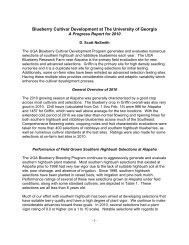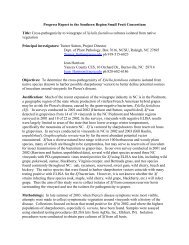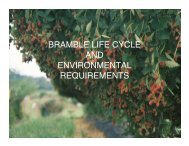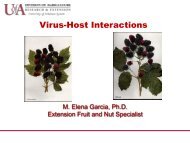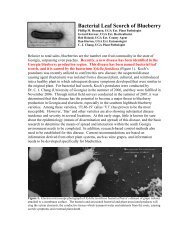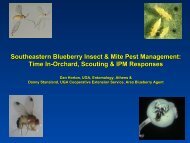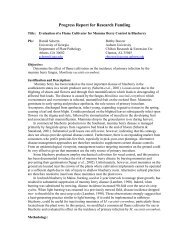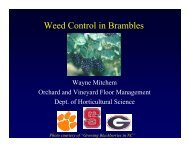Southeast Regional Blueberry Horticulture and Growth Regulator ...
Southeast Regional Blueberry Horticulture and Growth Regulator ...
Southeast Regional Blueberry Horticulture and Growth Regulator ...
Create successful ePaper yourself
Turn your PDF publications into a flip-book with our unique Google optimized e-Paper software.
your crop next season <strong>and</strong> the following season. However, do not remove more the 15% of the canopy in this procedure. Depending on thenumber of canes in the bush this is typically one or two canes removed per bush.3. Brush Wood Removal. On the remaining canes, systematically "thin out" flower buds by removing the shorter, thinner shoots(“brushwood”), leaving enough of the thick shoots to bear the crop <strong>and</strong> make new growth. Only experience can tell you how many shoots aparticular variety of a particular age can carry <strong>and</strong> still perform well. It is probably better in most instances to prune too lightly than too heavily.Lighter pruning is usually practiced as the plant grows older because it can carry more "wood" successfully due to a larger root system.4. If severe summer hedging is conducted, it is not necessary to make large shaping cuts or systematically thin out remaining canes. Summerhedging promotes thick vigorous canes with reduced numbers of flower buds.Winter Pruning Bearing Rabbiteye Plants – Rabbiteye blueberries over five years old usually benefit from cane renewal pruning. Cane renewalpruning involves removing about 15% of the canopy by cutting one to three of the oldest canes each winter about one or two inches from the crown,with loppers. Also during this process, remove as much dead wood as feasible. If mechanical harvest is being used, try to narrow the crown as muchas practical. Attempt to narrow the bush to one foot wide at the 18 inch level. This is where the “fish scales” of the mechanical harvester normallycontact the bush. On rabbiteye cultivars such as Climax, that have few canes, remove only a portion of a cane each year. Flower bud numbers <strong>and</strong>fruit set on rabbiteye blueberries is often lower than on highbush. For this reason, it is seldom necessary to do detailed h<strong>and</strong> pruning on rabbiteyes.Post Harvest or Summer Hedging – Post-harvest hedging is an optional practice that can be used to reduce winter pruning costs, adjust crop load<strong>and</strong> timing, <strong>and</strong> manage leaf spot diseases. Sickle bar or flail mowers can be used. Flail mowers are preferred because they are faster, have a widerrange of cutting angles <strong>and</strong> heights, <strong>and</strong> serve to both remove <strong>and</strong> chop (mulch) the prunings in a single pass. Flail mowers tend to shatter morecanes, but this has not resulted in more disease in North Carolina, <strong>and</strong> actually seems to stimulate more new shoots. Severe flail mowing ofsouthern highbush in Georgia is not recommended, as this has resulted in severe disease problems. For small operations, or in high densitybeds, hedging can be done with heavy-duty, h<strong>and</strong>-held gasoline shrub hedgers. A roof-top cut down each side of the row at about 45 to 55 degreesfrom the horizontal is recommended over a flat top cut.With rabbiteye blueberries the growing season remaining after harvest is relatively short, so it is important that hedging be conducted as soon afterharvest as possible. Mid to late July is best for hedging, but the procedure should be finished no later than the first week in August in North Carolina<strong>and</strong> mid-August in south Georgia. Normally only about 6 inches of regrowth occurs on rabbiteyes in the year of hedging, so the hedging cut shouldbe very moderate. No more than about 18 inches of bush height should be removed in one year. Avoid cutting into the main bearing area of thecanopy when possible. Ideally, start hedging in the year the bushes reach a height of seven feet if h<strong>and</strong> harvested <strong>and</strong> 7-9 feet if machine harvested.Remove cut debris from the bush after hedging to avoid disease problems. Fertilize <strong>and</strong> water well after hedging. Flowers on new growth producedafter hedging will bloom later than the rest of the bush <strong>and</strong> may require treatment for thrips in south Georgia.For highbush blueberries, most cultivars finish ripening in late May or early June in south Georgia <strong>and</strong> southeast North Carolina, therefore, a moresevere hedging can be conducted. If plants are growing in single rows in the field at 9 to 12 feet between rows, mature bushes can be “roof-top”hedged back immediately after harvest with the top of the “roof” cut at 4 to 5 feet. Select pruning height based on bush vigor <strong>and</strong> the length of thegrowing season remaining. Normally about 1.5 to 2.5 feet of regrowth occurs after harvest if the bushes have good vigor <strong>and</strong> are well fertilized <strong>and</strong>watered. In North Carolina, yields may be reduced the year following hedging on most cultivars except ‘O’Neal’ <strong>and</strong> ‘Reveille’. However, bud mite<strong>and</strong> fruit rot problems are reduced by hedging. Many growers in North Carolina summer roof-top hedge one year followed by winter cane renewal





